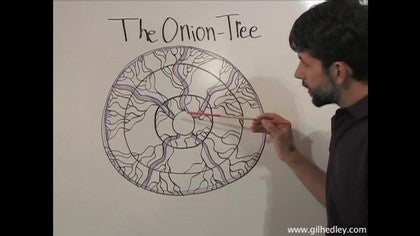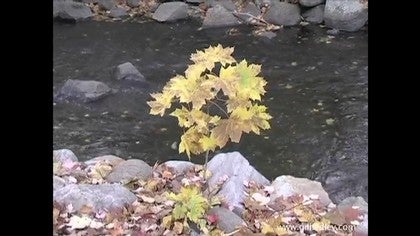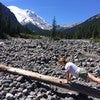Description
This video was filmed and produced by Gil Hedley. It includes videos and photos of dissections of cadavers (embalmed human donors). You can visit his website for more information about his workshops.
About This Video
Transcript
Read Full Transcript
[inaudible]
We also can become aware of our relationship to our bodies. We can use this process as an opportunity to notice our likes and dislikes and move towards an acceptance of the great gift our bodies represent. Beyond mechanistic models, we will look to the intelligence and forms of nature for ways to help us understand the body better. Like astronauts who bravely approached the frontiers of outer space in their quest for discovery. Together we will become so Minox navigating our bodies to the frontiers of space, the imagery contained in the sequences which follow our goals.
Extraordinary and intense. I invite you who view this to respect your comfort zones while you work to expand them and is our common intention to learn from this experience and to share the excitement of discovery. If you study with me in the lab, I bring you slowly into the experience step-by-step. Now sequences which follow have a similar organization but it will remain up to you to set the pace since a DVD permits you to skip this and that. So I encourage you especially if you are new to the dissection process to respect where you are and take this one step at a time.
The cadaver is by definition unembalmed body, not withstanding the value of working with fresh tissue, I prefer to work here with preserved tissue for the following reason. It enables me to demonstrate whole layers which would otherwise be nearly impossible to grasp and present under the time constraints of working with fresh tissue. Integral anatomy is concerned with whole body continuity's which are otherwise lost when taking a regional approach before entering the lab. Let's take a moment now to find in our hearts a place of acknowledgement and thanks for all donors and their families. We are all the beneficiaries of these precious gifts and through our study and exploration, we honor what has been offered to us and give our appreciation in return.
At this point we've opened the human door and we look upon the skin of an elderly woman's cadaver form. And a cadaver is not a person, it's simply a model of the body of a person. I say a model because,
In this instance, the skin has been desiccated rather than stretch taught by the embalming fluid. So it gives a slightly different look to the surface presentation. While it's true that the skin of the living is as a interesting to study is the skin of the dead.
Here we see another female form of slider proportion for the sake of comparison with the first morphology as a fascinating study. And a dissection is a road intuit. By morphology, I mean simply to say the study of shape. So when we look at a given cadavers forum, we can ask ourselves the question, or when we look at the form of a living, we can ask ourselves the question exactly which layer is it that's primarily presenting in a way that defines this person's shape. Is this person shaped by their, uh, by their organs primarily?
Are they presenting their superficial Fascia? And that's what gives them their characteristic shape. Perhaps they're shaped in particularly by their musculature, or perhaps they're shaped more particularly by their bony formation or defamation. So when we study anatomy in this way, we raise the questions, uh, about the layers and it helps us to get a bead on what we're looking at when we view a particular individual shape.
Now close up are very common surgical scar. The great saphenous vein has been removed in our country about 400,000 open heart surgeries a year are performed. So it's extremely common to observe these types of scarring in the cadavers. More common than not actually here observing more closely at the chest, we can see a midline incision and over by the shoulder, some dried out patches which are not indicative of anything at all. As we look more closely or we can just follow up the leg and grow accustomed to the coloration of the tissue. Um, the way it lies, the man is very lean. In this particular instance, we can see and uh, would come up close on the valley here. That's a little red patch, which we might fall down deeper if we remember it.
One can't always tell what a color indicates in a cadaver, whether it's in, sometimes we can tell very clearly if something's an artifact here of the surgery here at the neck area by the clavicle, we see the incision of the embalmer, the embalmer has to introduce the embalming fluids and they follow the route of the Jaguar en carotid vessels here the group has gathered around the table and uh, together we make these sorts of observations. And then from observation we moved to palpation feeling the cadaver form, massaging the tissues, discussing with one another, what we observe, pointing things out to one another and becoming comfortable in handling the form. In that sense, the palpation process serves a dual purpose, both of familiarizing ourselves with the cadaver and its mobility, uh, et cetera. And also rendering ourselves more comfortable in working with it. And then before differentiating or we've palpated once again
And you have to bring the right tool to the right task. I make a long incision and not very deep. This skin, although strong, isn't necessarily very thick as we'll see when we begin to lift this section of tissue. So by simply taking my hemostat and grabbing a corner, I'm able to pass my scalpel underneath and very quickly find my way to the depth of the layer I need to determine which is skin and which is superficial Fascia. So identify the superficial projection of the skin, the back of the skin, and then the underlying superficial Fascia.
Once I've identified my layers, then it's possible to differentiate them most effectively. And if I haven't clarified, uh, which layer is which, uh, which, uh, and where the transition of textures is, it's not possible to execute the idea of creating superficial Fascia man here. So once I'm clear on the tissue layer, then I can feel for it and it's integrity as I tell it with my hemostat and pass my scalpel blade through the relationships of the skin and superficial fashion, it's not really possible to reflect and remove the skin by hand. The mediation of the instrument is necessary. We can see a little bit of a superficial Fascia there on the back of the skin and then as we create some tension, as I create a tension on the tissue, it's possible to see the relationship of the skin to the superficial Fascia, which I then pass my blade through.
Sometimes even dividing the skin itself. Let me create those tensions and give a tug and then as possible to say, yes, I've got the skin and uh, to proceed with the project further as a larger area is exposed, then it becomes possible to make observations within the superficial Fascia itself. And there we can start to see tiny little blood vessels evident at this borderland where the skin and superficial fashion meat taking a larger view of this reflected skin. We can see clearly the two different layers demonstrated layers that just moments ago were United and an integral human form dissection of the entire human skin is really a team effort and when a group gets together, there's a certain intensity and focus in the air that seems to give evidence of the quality of skin itself. On ectodermal layer noted by Dean Juwann beautifully as the surface of the brain, the skin in a very real sense. It's the surface of the brain. It's periphery of sensing.
It's also remarkable in my opinion, to take the opportunity to, to compare the skin of the living and the skin of the cadaver. Oftentimes we imagine that our life force is most readily witnessed in our eyes and yet, uh, here it's powerfully clear that the life, energy and life force pulses forth from our living skin. And it's a stark comparison with that of the cadaver skin. Each area of the body presents its own challenges for the dissector. Curved surfaces can be more challenging than relatively flat ones.
And at the same time we also take note of different thicknesses of the skin. It's thin by the Shin, thicker by the shoulder, and all of these present challenges for the dissector. Now this point in the dissection progression with this particular form, we've moved past observation, POW patient in differentiation. We're at the point where we can reflect the skin as a whole. It's an exciting moment for the group as we reveal to you superficial fashion man, a creature just beneath the surface of the skin.
The skin ultimately is like a mask layer. It hides a more vulnerable creature just beneath that surface. It's a rare vision to be able to see superficial fashion man in his entirety.
Um, but for now we just take in the, the vista of the cadaver form with skin on and with skin off. The scalpel blade goes dull in this effort because really the skin doesn't want to be separated. The skin is the skin of the body. It represents the periphery of the vascular and neuro trees. So it's as if we've cut all the leaves off of a tree and full foliage in that sense. In that we've taken away the peripheral end points. And in doing so in severing those relationships and disrupting that union, many, many scalpel blades go doll in the process of differentiating and reflecting and removing the skin.
There can be no doubt in our minds. However, at this point, the unity of skin and itself as a layer as well as its intimate relationship with the superficial Fascia immediately beneath it as the next textural layer. Now in keeping with the dissection progression, the time comes when having not only reflected and removed the skin, we have the opportunity to dissect further, to observe and paid the skin as an independent structure, a new creation the first time a skin unto itself. And so here we see the skin held aloft by the group. Uh, we're looking at the, the outer surface of the skin. The back is in the center of the legs hanging down like boots on the arms and head and neck region held aloft. It's a profound sight. It's heavy and completely compelling. Uh, for the groups observation.
Seeing the skin in this way prompts us to consider as many functions as well. The skin of course serves at some level as a barrier. It has it's immune function. We are protected by our skin from the intrusion of substances without into our bloodstream. At the same time the skin is permeable. We can excrete through our skin and in doing so, you know we regulate our temperature and are the salt content of our body, et cetera.
And at the same time it's permeable in the other direction so that we can see clearly demonstrated here how light can pass through at certain frequencies of the electromagnetic spectrum. And when we see that we can consider what, what the interactions might be of that light with our skin and with our physiology within. Of course, we know that vitamin D is formed in our skin through its interaction with light or we might also consider well in comparing the blood flow, our entire blood supply flows through our eyeballs about every two hours and Vat exposes our blood to the ultraviolet frequencies and their cleansing properties and certainly has an important immune function. And as important for our health and we should all admit ourselves to the sunlight at least two hours a day to assure, um, that our blood is cleansed in that way. At the same time, we can see that the skin being the hatter, most peripheral terminus of our vast neurovascular trees.
So while the skin, uh, defines bodies visually to the normal, um, and non clairvoyant, since our heart waves and our brainwaves and goodness knows our liver waves to can certainly project themselves beyond the skin. And it's that fact that, uh, enables us to use an EKG or an EEG to sense those waves permeating through our skin into our surrounding environment and imprinting our surrounding environment. With the wavelengths of our habitual patterns of being. Now we'll take a closer look at the skin here. There's a patch of skin prepared for our observation.
It's positioned as it was in the form originally, although all of its relationships have been severed so that we can reflect it back and flip it over and look at the skin close up. The patterns that we observe on the back of the skin here are common through much of the body where the skin has some substantial thickness at places where it's very much thinner, say at the eyelid or at the Shin. We won't find this kind of patterning, which looks very much like on the surface of a cantaloupe. Although in the skin it represents an elastic, stretchy fabric, which conforms to all of the complex movements of the underlying structures. And it's quite amazing how this living fabric is able to constantly conform, to elongate and to contract back with the elongation of our forum at large.
We take a closer look then at the edge of the skin, uh, we can see its thickness here in cross section. Uh, perhaps a few millimeters. Uh, skin can be quite thin. Sometimes. Say again at the eyelid, maybe only one millimeter thick. Uh, here it's several millimeters and at the shoulders sometimes can be even twice this thick underlying the skin. The superficial Fascia reflects the patterning that we see on the back of the skin. The bubbly matrix of the superficial Fascia meets up with the complex web of the skin. It's those relationships that we severed already and it's through this superficial Fascia that the, uh, neurovascular trees perforate and reach out and stretch to their utmost periphery in the skin where blending heart and neural tree together and they form this complex web of nourishment and sensitivity combined. That rich combination is the inherent nature of our skin.
And then we have what's call that, uh, uh, I, uh, a membranous layer or a flat layer, or maybe a planner layer or something like that. Uh, this outer most layer and these also. And then here we have, let's call this a fluffy layer because it's kind of wide and fluffy. So here we have our skin off flat membranous layer, and then we have this fluffy layer and this superficial fashion. And then look, we encounter again a membranous layer, just like in an onion, and I'll call that our deep fashion, which underlies our superficial fashion and coats our musculature. So this fluffy layer. Then here, this broad wide layer would represent our muscle layer on our muscle tissue. And deep to that, well we have of course the bags that surround our viscera, the bags around our organs, whether they be fibers, bags or uh, cirrus membranes that we'll investigate when we get on to the viscera in further DVDs. But for now we'll just indicate that there is this sort of flat plant or membranous layer on surrounding our Oregon tissue, which would be represented by this fluffy layer.
So we have our skin on that ring, our deep fascia and the bags around our organs here. And then the twixt, these planner layers. We have our superficial Fascia, our muscle layer, and our organs. So now let's study our tree. So if this were to represent the brain, then here, then the branchings of the brain from the center to the periphery. Here we have all these nerves coming off following our limbs as at work.
Just like a tree and those nerves will be penetrating each layer and contacting each layer on their way out to the periphery, at which point they become so complex and substantial that they actually comprise the ring itself. Almost the same can be said for the heart, uh, the whole heart when understood that way where it starts here at the center and then branches out, uh, following these pathways of the limbs out to the periphery in greater and greater complexity, uh, right along with the nervous tissue. So our neurovascular trees are traveling out from the center to the periphery and as they do so they do two things. They perforate and contact the layers along the way to the outermost ring. And also they become more and more, uh, complex and smaller. So the branches become tiny out on the periphery, whereas they were trunk like at the beginning.
So this is something we'll notice while we do dissection as well, that the deeper we go into the form, the bigger the branches get. And we'll start to kind of, we, as we looked at the superficial fashions, superficial projection, when we just peeked underneath the skin, we saw these tiny little blood vessels. Uh, as we go deeper, as we look into the superficial passion itself, as we look beneath it, we'll begin to see that the perforating vessels start to get larger and larger until we find ourselves at these great trunks like the aorta on our way back to the center of the tree of the heart tree. So, and the same goes for the nervous system. Of course, as we find our way back to the trunk of that tree, the spinal cord. So here's the onion tree model. It's a simplification. That's our intention, is to provide a simplification from nature that creates healthful analogies in our understanding of the human form. So we can explain what we see too on another
Integral Anatomy: The Integral Anatomy Series
Comments
You need to be a subscriber to post a comment.
Please Log In or Create an Account to start your free trial.


















